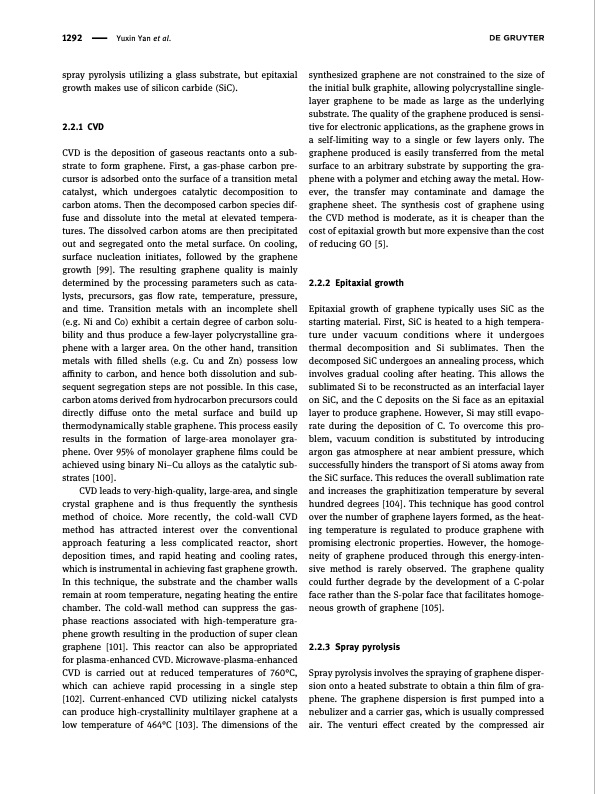
PDF Publication Title:
Text from PDF Page: 009
1292 Yuxin Yan et al. spray pyrolysis utilizing a glass substrate, but epitaxial growth makes use of silicon carbide (SiC). 2.2.1 CVD CVD is the deposition of gaseous reactants onto a sub- strate to form graphene. First, a gas-phase carbon pre- cursor is adsorbed onto the surface of a transition metal catalyst, which undergoes catalytic decomposition to carbon atoms. Then the decomposed carbon species dif- fuse and dissolute into the metal at elevated tempera- tures. The dissolved carbon atoms are then precipitated out and segregated onto the metal surface. On cooling, surface nucleation initiates, followed by the graphene growth [99]. The resulting graphene quality is mainly determined by the processing parameters such as cata- lysts, precursors, gas flow rate, temperature, pressure, and time. Transition metals with an incomplete shell (e.g. Ni and Co) exhibit a certain degree of carbon solu- bility and thus produce a few-layer polycrystalline gra- phene with a larger area. On the other hand, transition metals with filled shells (e.g. Cu and Zn) possess low affinity to carbon, and hence both dissolution and sub- sequent segregation steps are not possible. In this case, carbon atoms derived from hydrocarbon precursors could directly diffuse onto the metal surface and build up thermodynamically stable graphene. This process easily results in the formation of large-area monolayer gra- phene. Over 95% of monolayer graphene films could be achieved using binary Ni–Cu alloys as the catalytic sub- strates [100]. CVD leads to very-high-quality, large-area, and single crystal graphene and is thus frequently the synthesis method of choice. More recently, the cold-wall CVD method has attracted interest over the conventional approach featuring a less complicated reactor, short deposition times, and rapid heating and cooling rates, which is instrumental in achieving fast graphene growth. In this technique, the substrate and the chamber walls remain at room temperature, negating heating the entire chamber. The cold-wall method can suppress the gas- phase reactions associated with high-temperature gra- phene growth resulting in the production of super clean graphene [101]. This reactor can also be appropriated for plasma-enhanced CVD. Microwave-plasma-enhanced CVD is carried out at reduced temperatures of 760°C, which can achieve rapid processing in a single step [102]. Current-enhanced CVD utilizing nickel catalysts can produce high-crystallinity multilayer graphene at a low temperature of 464°C [103]. The dimensions of the synthesized graphene are not constrained to the size of the initial bulk graphite, allowing polycrystalline single- layer graphene to be made as large as the underlying substrate. The quality of the graphene produced is sensi- tive for electronic applications, as the graphene grows in a self-limiting way to a single or few layers only. The graphene produced is easily transferred from the metal surface to an arbitrary substrate by supporting the gra- phene with a polymer and etching away the metal. How- ever, the transfer may contaminate and damage the graphene sheet. The synthesis cost of graphene using the CVD method is moderate, as it is cheaper than the cost of epitaxial growth but more expensive than the cost of reducing GO [5]. 2.2.2 Epitaxial growth Epitaxial growth of graphene typically uses SiC as the starting material. First, SiC is heated to a high tempera- ture under vacuum conditions where it undergoes thermal decomposition and Si sublimates. Then the decomposed SiC undergoes an annealing process, which involves gradual cooling after heating. This allows the sublimated Si to be reconstructed as an interfacial layer on SiC, and the C deposits on the Si face as an epitaxial layer to produce graphene. However, Si may still evapo- rate during the deposition of C. To overcome this pro- blem, vacuum condition is substituted by introducing argon gas atmosphere at near ambient pressure, which successfully hinders the transport of Si atoms away from the SiC surface. This reduces the overall sublimation rate and increases the graphitization temperature by several hundred degrees [104]. This technique has good control over the number of graphene layers formed, as the heat- ing temperature is regulated to produce graphene with promising electronic properties. However, the homoge- neity of graphene produced through this energy-inten- sive method is rarely observed. The graphene quality could further degrade by the development of a C-polar face rather than the S-polar face that facilitates homoge- neous growth of graphene [105]. 2.2.3 Spray pyrolysis Spray pyrolysis involves the spraying of graphene disper- sion onto a heated substrate to obtain a thin film of gra- phene. The graphene dispersion is first pumped into a nebulizer and a carrier gas, which is usually compressed air. The venturi effect created by the compressed airPDF Image | Synthesis of graphene Potential carbon precursors

PDF Search Title:
Synthesis of graphene Potential carbon precursorsOriginal File Name Searched:
10-1515-ntrev-2020-0100.pdfDIY PDF Search: Google It | Yahoo | Bing
Salgenx Redox Flow Battery Technology: Power up your energy storage game with Salgenx Salt Water Battery. With its advanced technology, the flow battery provides reliable, scalable, and sustainable energy storage for utility-scale projects. Upgrade to a Salgenx flow battery today and take control of your energy future.
| CONTACT TEL: 608-238-6001 Email: greg@infinityturbine.com | RSS | AMP |